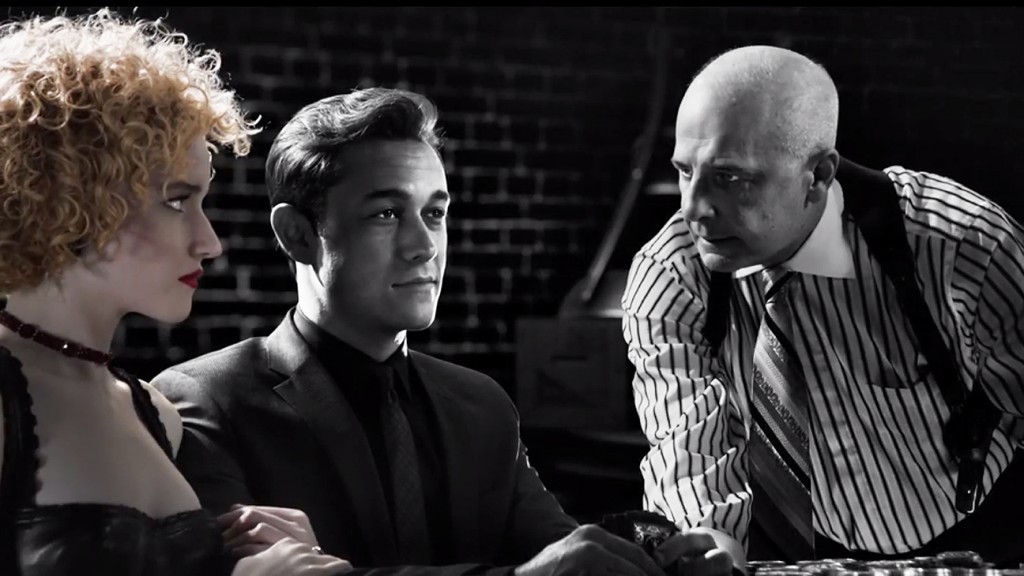Miller Lite
As a prominent figure of international filmmaking, Robert Rodriguez’s creative energy is his greatest asset. It’s also a decisive hinderance to the quality of his rapidly developed filmic output. Rodriguez’ advocacy of filmmaking free of pretension is exceptionally admirable, but it’s an unfortunately uncommon sentiment amongst the Hollywood elite. In 2005, Rodriguez withdrew from the Directors Guild of America, who refused to recognise Frank Miller as co-director of Sin City. Nine years later, Miller (the author of the graphic novels on which these films are based) and Rodriguez are back with the somewhat anticipated sequel, Sin City: A Dame To Kill For.
The title itself, in truth, refers to only one of three stories that comprise the film. Like the 2005 original, Sin City: A Dame To Kill For is a series of brief and brutal vignettes, rather than a consistent whole. And like the original, the quality peaks and dips frequently. Rodriguez’s frenzied filmmaking is a hindering byproduct of his seemingly insatiable enthusiasm that has, in recent years, seen the filmmaker’s work delve into a distinctly Corman-esque ‘throw enough shit at the wall’ territory. There’d be nothing particularly wrong with that if Rodriguez’s work didn’t so often convey the impression that the man could be capable of something quite memorable were he to invest slightly more time and consideration.
The Sin City films are more hyper-noir than anything that genuinely resembles film noir. There’s not a soft light in frame, the characters occupy the extreme corners of grit and cowardice and the dialogue is so self-consciously hardboiled that even Raymond Chandler might have hesitated to commit it to paper. The original Sin City suffered as a result of Rodriguez’s utterly literal approach to the graphic novel to film translation as well as the excessiveness in absolutely every on-screen element. Sin City: A Dame To Kill For has no less enthusiasm for exaggeration, but Rodriguez’s has thankfully brought his cinematic sensibilities to the adaption process, expresses a sense of tension and atmosphere that were absent from the original.
Of the three stories in Sin City: A Dame To Kill For, only one (itself titled “A Dame To Kill For”) is actually an adaptation of Frank Miller’s graphic novels. Dwight (Josh Brolin, played by Clive Owen in 2005), is a photographic private detective with a sordid but ambiguous past. His life is thrown into chaos when a past lover, Ava (an omninude Eva Green) arrives out of nowhere in need of his assistance. This segment, which punctuates the middle of the film, is Sin City at its most compelling – thanks particularly to Green, who’s corrupt seductress is so enticing it’s not difficult to understand why Dwight is utterly weak to her charms.
The other two stories, entitled “The Long Bad Night” and “Nancy’s Last Dance”, were generated by Miller exclusively for this film and for whatever reason are noticeably weaker than the “A Dame To Kill For” segment. “Nancy’s Last Dance”, which focuses on the aftermath of Hartigan’s death in the first film, languishes in a pit of uninspired plotting, poor performances and repellingly ugly violence. “The Long Bad Night”, following a cocky young gambler named Johnny (Joseph Gordon Levitt) fares slightly better, although Green’s absence is notable and lamentable.
Areas of the city are revisited, fleshed out and given more context within their urban space. Characters that were part of the original but never met ultimately interact in this sequel, offering Miller’s world a greater sense of cohesion. Sin City: A Dame To Kill For becomes a worthy sequel when absorbed within the context of the first. In this sense, the film might have fared better had it been released closer to the original. Miller and Rodriguez may have missed their opportunity to effectively capitalise on the energy of Sin City.
Despite best intentions and a naturally cinematic intuition, Robert Rodriguez is hindered by his own lack of moderation and observation. His filmmaking is an allegorical answer to Kubrick’s meticulous planning and deliberation – passion over patience. Sin City: A Dame To Kill For is, for the most part, an enjoyable pulpy way to kill some time, but the latest in a string of haphazard films from a director that may be capable of far more.
6/10
For more Reviews, click here. If you’re digging ReelGood, sign up to our mailing list for exclusive content, early reviews and chancesto win big!


